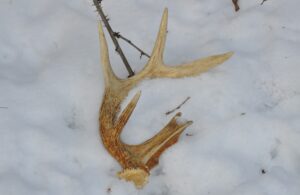Photography courtesy of Lowell Washburn, all rights reserved.
Iowa bucks are suddenly losing their heads — or at least the showiest parts of them.
By the time mid-February rolls around, North Iowa’s white-tailed bucks will have begun dropping their antlers. For outdoor enthusiasts, it’s an annual Call to Arms as a willing legion of shed hunters invade local woodlands in search of lost treasure. During recent years, the search for discarded antlers — shed hunting — has become one of our fastest growing forms of outdoor recreation.

Traditionally the domain of deer hunting males, shed hunting demographics are changing. A surprising number of New Age antler hunters do not hunt deer during Iowa’s archery and gun seasons. Some are nonhunters and a growing number are female. One thing that hasn’t changed is that, once hooked, the search for antlers can become an obsession. Some collectors go so far as to schedule annual vacations around shed hunting; logging in hundreds of miles — by foot and by vehicle — in hopes of finding an antler that is bigger, better, or more unique in design than the last. Some aficionados go so as to keep and train antler hunting dogs which are bred, at least in part, for this highly specialized task.

The early birds get the worm, and as late winter snow cover begins to recede, competition intensifies. Even though some bucks are still carrying their head gear, antler enthusiasts are already scouring rural landscapes. But not all competitors wear stocking caps, insulated boots or travel on two legs. Squirrels, white-footed mice, and other small mammals are also looking to cash in on their fair share of the bounty. But local squirrel populations aren’t collecting sheds for their trophy value, of course. Instead, the bushy-tails covet cast off antlers for their rich deposits of calcium and other minerals. Nothing goes to waste in the outdoors. Woodland rodents had already been efficiently recycling cast off antlers centuries before we humans invented the word.


 Tom Cope
Tom Cope Sue Wilkinson
Sue Wilkinson Susan Judkins Josten
Susan Judkins Josten Rudi Roeslein
Rudi Roeslein Elyssa McFarland
Elyssa McFarland Mark Langgin
Mark Langgin Adam Janke
Adam Janke Joe Henry
Joe Henry Kristin Ashenbrenner
Kristin Ashenbrenner Joe Wilkinson
Joe Wilkinson Dr. Tammy Mildenstein
Dr. Tammy Mildenstein Sean McMahon
Sean McMahon